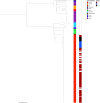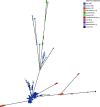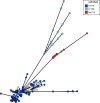Core-Genome Multilocus Sequence Typing for Epidemiological and Evolutionary Analyses of Phytopathogenic Xanthomonas citri
- PMID: 37067413
- PMCID: PMC10231234
- DOI: 10.1128/aem.02101-22
Core-Genome Multilocus Sequence Typing for Epidemiological and Evolutionary Analyses of Phytopathogenic Xanthomonas citri
Abstract
Xanthomonas citri subsp. citri is the cause of bacterial citrus canker, responsible for major economic losses to the citrus industry. X. citri subspecies and pathovars are responsible for diseases in soybean, common bean, mango, pomegranate, and cashew. X. citri disease has been tracked using several typing methods, but recent studies using genomic sequencing have been key to understanding the evolutionary relationships within the species, including fundamental differences among X. citri subsp. citri pathotypes. Here, we describe a core-genome multilocus sequence typing (cgMLST) scheme for X. citri based on 250 genomes comprising multiple examples of X. citri subsp. citri pathotypes A, A*, and Aw; X. citri subsp. malvacearum; X. citri pv. aurantifolii, pv. fuscans, pv. glycines, pv. mangiferaeindicae, pv. viticola, and pv. vignicola; and single isolates of X. citri pv. dieffenbachiae and pv. punicae. This data set included genomic sequencing of 100 novel X. citri subsp. citri isolates. cgMLST, based on 1,618 core genes across 250 genomes, is implemented at PubMLST (https://pubmlst.org/organisms/xanthomonas-citri/). GrapeTree minimum-spanning tree and Interactive Tree of Life (iTOL) neighbor-joining phylogenies generated from the cgMLST data resolved almost identical groupings of isolates to a core-genome single nucleotide polymorphism (SNP)-based neighbor-joining phylogeny. These resolved identical groupings of X. citri subsp. citri pathotypes and X. citri subspecies and pathovars. X. citri cgMLST should prove to be an increasingly valuable resource for the study of this key species of plant-pathogenic bacteria. Users can submit genomic data and associated metadata for comparison with previously characterized isolates at PubMLST to allow the rapid characterization of the local, national, and global epidemiology of these pathogens and examine evolutionary relationships. IMPORTANCE Xanthomonas citri is a plant pathogen that causes major economic losses to the citrus industry and sweet orange production in particular. Several subspecies and pathogens are recognized, with host ranges including soybean, common bean, mango, pomegranate, and cashew, among others. Recent genomic studies have shown that host-adapted X. citri subspecies and pathovars and X. citri subsp. citri pathotypes form distinct clades. In this study, we describe a core-genome multilocus sequence typing (cgMLST) scheme for this species that can rapidly and robustly discriminate among these ecologically distinct, host-adapted clades. We have established this scheme and associated databases containing genomic sequences and metadata at PubMLST, which users can interrogate with their own genome sequences to determine X. citri subspecies, pathovars, and pathotypes. X. citri cgMLST should prove to be an invaluable tool for the study of the epidemiology and evolution of this major plant pathogen.
Keywords: MLST; Xanthomonas citri; cgMLST; citrus canker.
Conflict of interest statement
The authors declare no conflict of interest.
Figures




Similar articles
-
Reclassification of Xanthomonas campestris pv. citri (ex Hasse 1915) Dye 1978 forms A, B/C/D, and E as X. smithii subsp. citri (ex Hasse) sp. nov. nom. rev. comb. nov., X. fuscans subsp. aurantifolii (ex Gabriel 1989) sp. nov. nom. rev. comb. nov., and X. alfalfae subsp. citrumelo (ex Riker and Jones) Gabriel et al., 1989 sp. nov. nom. rev. comb. nov.; X. campestris pv malvacearum (ex smith 1901) Dye 1978 as X. smithii subsp. smithii nov. comb. nov. nom. nov.; X. campestris pv. alfalfae (ex Riker and Jones, 1935) dye 1978 as X. alfalfae subsp. alfalfae (ex Riker et al., 1935) sp. nov. nom. rev.; and "var. fuscans" of X. campestris pv. phaseoli (ex Smith, 1987) Dye 1978 as X. fuscans subsp. fuscans sp. nov.Syst Appl Microbiol. 2005 Aug;28(6):494-518. doi: 10.1016/j.syapm.2005.03.017. Syst Appl Microbiol. 2005. PMID: 16104350
-
Ecological and Evolutionary Insights into Xanthomonas citri Pathovar Diversity.Appl Environ Microbiol. 2017 Apr 17;83(9):e02993-16. doi: 10.1128/AEM.02993-16. Print 2017 May 1. Appl Environ Microbiol. 2017. PMID: 28258140 Free PMC article.
-
A Multilocus Sequence Typing Scheme for Rapid Identification of Xanthomonas citri Based on Whole-Genome Sequencing Data.Phytopathology. 2024 Jul;114(7):1480-1489. doi: 10.1094/PHYTO-12-23-0490-R. Epub 2024 Jul 11. Phytopathology. 2024. PMID: 38669587
-
A Comprehensive Overview of the Genes and Functions Required for Lettuce Infection by the Hemibiotrophic Phytopathogen Xanthomonas hortorum pv. vitians.mSystems. 2022 Apr 26;7(2):e0129021. doi: 10.1128/msystems.01290-21. Epub 2022 Mar 21. mSystems. 2022. PMID: 35311560 Free PMC article. Review.
-
Xanthomonas as a Model System for Studying Pathogen Emergence and Evolution.Phytopathology. 2024 Jul;114(7):1433-1446. doi: 10.1094/PHYTO-03-24-0084-RVW. Epub 2024 Jul 5. Phytopathology. 2024. PMID: 38648116 Review.
Cited by
-
Evolution and spread of Xanthomonas citri subsp. citri in the São Paulo, Brazil, citrus belt inferred from 758 novel genomes.Microb Genom. 2025 Jan;11(1):001338. doi: 10.1099/mgen.0.001338. Microb Genom. 2025. PMID: 39817540 Free PMC article.
-
Phylogenomic analysis of 343 Xanthomonas citri pv. citri strains unravels introduction history and dispersal paths.PLoS Pathog. 2023 Dec 15;19(12):e1011876. doi: 10.1371/journal.ppat.1011876. eCollection 2023 Dec. PLoS Pathog. 2023. PMID: 38100539 Free PMC article.
References
-
- Behlau F, Gochez AM, Jones JB. 2020. Diversity and copper resistance of Xanthomonas affecting citrus. Trop Plant Pathol 45:200–212. doi:10.1007/s40858-020-00340-1. - DOI
-
- Ference CM, Gochez AM, Behlau F, Wang N, Graham JH, Jones JB. 2018. Recent advances in the understanding of Xanthomonas citri ssp. citri pathogenesis and citrus canker disease management: Xcc pathogenesis and citrus canker management. Mol Plant Pathol 19:1302–1318. doi:10.1111/mpp.12638. - DOI - PMC - PubMed
-
- Gordon JL, Lefeuvre P, Escalon A, Barbe V, Cruveiller S, Gagnevin L, Pruvost O. 2015. Comparative genomics of 43 strains of Xanthomonas citri pv. citri reveals the evolutionary events giving rise to pathotypes with different host ranges. BMC Genomics 16:1098. doi:10.1186/s12864-015-2310-x. - DOI - PMC - PubMed
Publication types
MeSH terms
Supplementary concepts
Grants and funding
LinkOut - more resources
Full Text Sources

